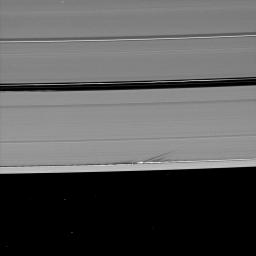
|
Slanting Shadows
- Click the image above for a larger view
- Full-Res JPEG (1014 x 1014) (87.6 kB)
- Full-Res TIFF (1014 x 1014) (1.0 MB)
Caption:
Long shadows stretch away from the towering edge waves created by the gravity of the moon Daphnis in this image taken a little more than a week before Saturn's August 2009 equinox.
Tiny Daphnis (8 kilometers, or 5 miles across) appears as a bright dot in the Keeler Gap near the tall edge waves it has created in the A ring. The moon has an inclined orbit and its gravitational pull both perturbs the orbits of the particles of the A ring forming the Keeler Gap's edge and sculpts the edge into waves having both horizontal (radial) and out-of-plane components. Material on the inner edge of the gap orbits faster than the moon so that the waves there lead the moon in its orbit. Material on the outer edge moves slower than the moon, so waves there trail the moon. See PIA11656 to learn more about this process. Both the moon and the edge waves can be seen casting shadows in this image.
This view looks toward the northern, unilluminated side of the rings from about 38 degrees above the ringplane. Background stars, including three stars shining through the rings, are visibly elongated by the motion of the spacecraft during the image's exposure.
The novel illumination geometry that accompanies equinox lowers the sun's angle to the ringplane, significantly darkens the rings, and causes out-of-plane structures to look anomalously bright and cast shadows across the rings. These scenes are possible only during the few months before and after Saturn's equinox, which occurs only once in about 15 Earth years. Before and after equinox, Cassini's cameras have spotted not only the predictable shadows of some of Saturn's moons (see PIA11657 ), but also the shadows of newly revealed vertical structures in the rings themselves (see PIA11665 ).
The image was taken in visible light with the Cassini spacecraft narrow-angle camera on July 28, 2009. The view was obtained at a distance of approximately 983,000 kilometers (611,000 miles) from Daphnis. Image scale is 6 kilometers (4 miles) per pixel.
Background Info:
The Cassini-Huygens mission is a cooperative project of NASA, the European Space Agency and the Italian Space Agency. The Jet Propulsion Laboratory, a division of the California Institute of Technology in Pasadena, manages the mission for NASA's Science Mission Directorate, Washington, D.C. The Cassini orbiter and its two onboard cameras were designed, developed and assembled at JPL. The imaging operations center is based at the Space Science Institute in Boulder, Colo.
For more information about the Cassini-Huygens mission visit http://saturn.jpl.nasa.gov/ . The Cassini imaging team homepage is at http://ciclops.org .
Cataloging Keywords:
| Name | Value | Additional Values |
|---|---|---|
| Target | Daphnis | A Ring, Saturn Rings |
| System | Saturn | |
| Target Type | Satellite | Ring |
| Mission | Cassini-Huygens | |
| Instrument Host | Cassini Orbiter | |
| Host Type | Orbiter | |
| Instrument | Imaging Science Subsystem (ISS) | |
| Detector | Narrow Angle Camera | |
| Extra Keywords | Gap, Grayscale, Shadow, Visual, Wave | |
| Acquisition Date | ||
| Release Date | 2009-11-23 | |
| Date in Caption | 2009-07-28 | |
| Image Credit | NASA/JPL/Space Science Institute | |
| Source | photojournal.jpl.nasa.gov/catalog/PIA11629 | |
| Identifier | PIA11629 | |
